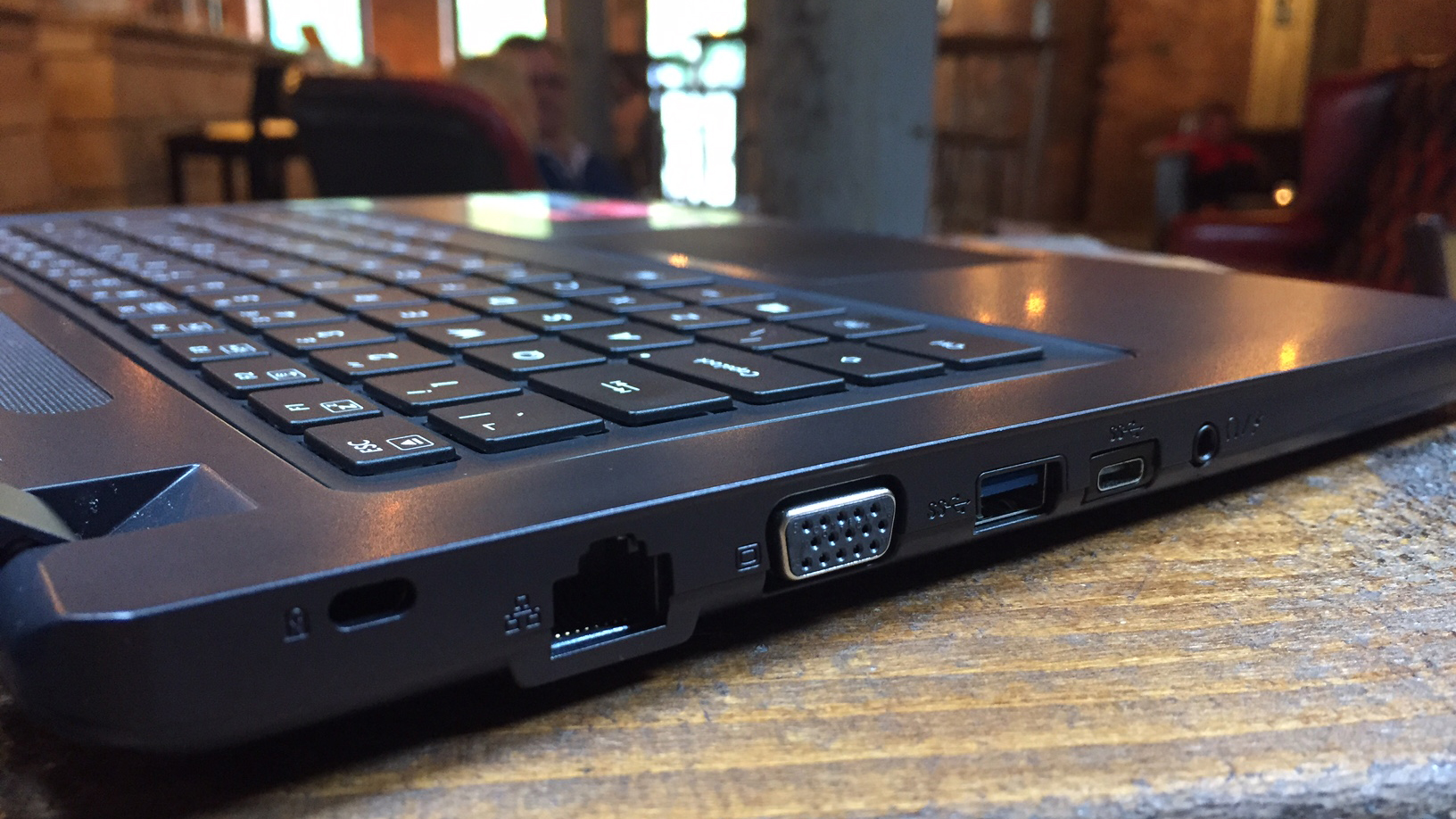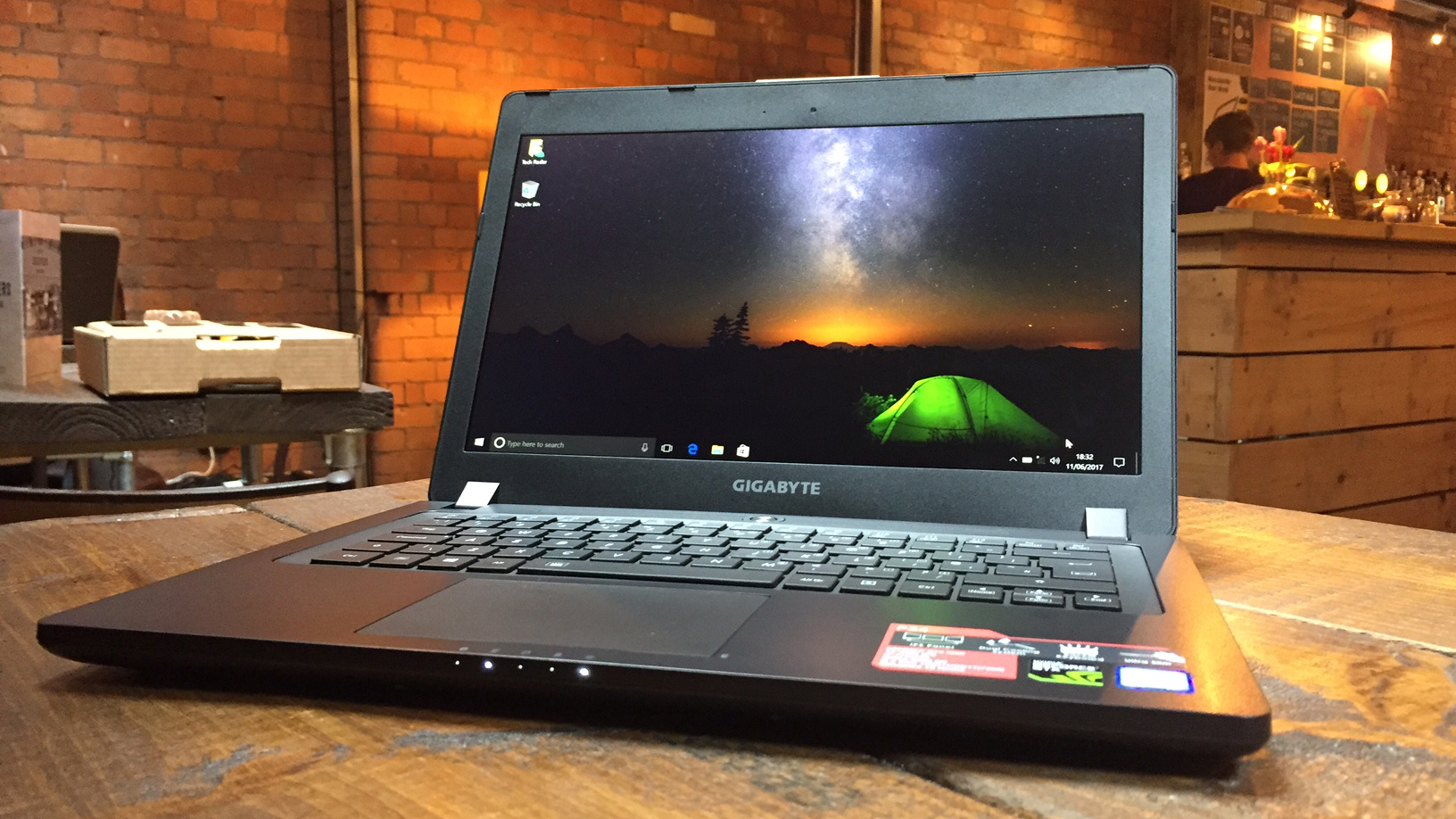TechRadar Verdict
Gigabyte continue their medium-specced P34 line with a machine that performs well and blends in with co-workers. Although we’d like more battery time.
Pros
- +
Light, thin and stylish
- +
Quiet and efficient cooling
- +
Good touchpad
Cons
- -
Poor battery life
- -
Only 2GB of GDDR
- -
Bouncy keyboard
Why you can trust TechRadar
The Taiwanese component giant Gigabyte have been making their P34 range of gaming laptops for a while now. We reviewed one of its previous incarnations favorably back in 2014.
They’re a quality, or should we say mature, gaming line. They’re sometimes not the fastest, flashiest ones out there, instead they’ve got a couple of twists.
Firstly, as you’d expect they’re packed with quality parts, but they’re packaged unusually, at least for gamers’ tastes. These aren’t the neon flashing, cyborg peacocks we’re used to (ahem... Acer Predator 21 X), they’re for sophisticated gamers. Ones who don’t want to draw attention to themselves on a train while preventing the world from alien invasion.
And the other twist? We tend to think of games-capable laptops as being humongous, chunky and defying all notions of portability. Instead this is thin and light, weighing in at 3.73 pounds (1.69kg) and a slender 0.87 inches (22.2mm) thick.
But are you willing to sacrifice that disco flashing Cherry MX keyboard and neon lid logo that looks like the Eye of Sauron for less weight to carry around? And just how do they compare specs and performance wise? Well, let’s see...

Price, availability and value
So how does the Gigabyte P34G v7 compare to other gaming laptops price-wise? The new Alienware 13 R3 is certainly a thing of beauty, but you’ll be paying heftily for that OLED screen.
The entry level Gigabyte P34G v7 is admittedly cheaper than this at $1,595 (£1,249.99, $2,115 AUD), but for that you’ll get a slower i5-7300HQ, a smaller 180SSD and no option for an extra HD. The Gigabyte has a whopping 1TB of secondary storage included, so they really have thought about gamers.
Sign up for breaking news, reviews, opinion, top tech deals, and more.
And what about the Dell Inspiron 15 Gaming? We reviewed the lower spec i5-7300HQ. Heading to their website there is a model that’s comparable to the P34. The next rung up clocks in at $1,395 (£1,099.00, $1,860 AUD) and includes the same i7-7700HQ as seen here, with the same sized hard drives (although the second drive is just 5,400rpm).
But wait, it has double the amount of RAM and double the amount of graphics memory on the same GPU. And while we haven’t got the TechRadar benchmarks on that particular machine, at $255 (£200, $340 AUD) less but for more GPU RAM and normal RAM it’s certainly tempting.

Here is the P34G v7 configuration sent to TechRada for review:
CPU: 2.80GHz Intel Core i7-7700HQ (6M Cache, up to 3.80 GHz)
Graphics: NVIDIA GeForce GTX 1050 (2GB GDDR5 RAM), Intel HD Graphics 630
RAM: 8GB DDR4 (2400MHz)
Screen: 14-inch, Full HD 1920 x 1080 IPS Wide Viewing Angle LCD
Storage: 256GB Liteon SSD + 1TB Hitachi 7200 RPM
Ports: 3 x USB 3.0 (Type-A), 1 x USB 3.1(Type-C), HDMI 1.4, D-sub, RJ45, Headphone-out jack (Audio-in Combo), SD Card Reader, DC-in Jack
Connectivity: LAN:10/100/1000Mbps Ethernet, Wireless LAN: 802.11 ac (a/b/g/n compatible), Bluetooth V4.2 + LE
Camera: HD Camera
Weight: 3.73 pounds (1.69kg)
Size: 13.4x 9.4 x 0.87 inches, (340 x 239 x 22.2mm) (W x D x H)
Design
Let’s be honest, P34G v7 looks a bit like a 1990s IBM Thinkpad. It’s encased in thick black, with a thin grey bar to mark where the lid opens. The Gigabyte logo is inset in tasteful silver right in the center of a reassuringly solid black (of course) aluminium lid. OK so the base is plastic, but on the plus side there are a number of Phillips screws there to easily upgrade the RAM up to 32GB.
It also plays it safe with the ports: a traditional round DC power port on the right along with an HDMI and a couple of USB 3.0s and an SD card slot.
On the left there’s another USB 3.0 (thankfully no USB 2.0s here at all), plus a USB C, network, combined headphone/mic and a VGA display port for all your old school gaming requirements. It’s nothing out of the ordinary, but that’s what you want from ports.
Pumping out of the rear of the machine are two large fans, and they’re part of Gigabyte’s exclusive Supra-cool technology. One is located across the Esc and F3 keys on the left side and the other under the F11 and Del on the right.
Twin heat pipes join them together in the centre and they both draw heat from both the CPU and GPU. They’re surprisingly quiet, even when pushed and set to gaming mode within Gigabyte’s supplied Smart Manager software. The cooling system also keeps the thickness of the machine down too, according to Gigabyte. And while it isn’t the slimmest of gaming laptops, the Razer Blade’s 0.7 inches (17.9mm) is hard to beat, 0.87 inches (22.2mm) is perfectly serviceable for the specs and price.
However, it does mean that in practical terms that if you’re using it just on your knees, you will get quite hot, so keep it on a desk. It’s also wise (as with any high performance laptop) to keep the back clear from obstacles as that’s the only ventilation point.

Just to the left and right of the fans are two large sturdy hinges, and unlike the recently reviewed Dell Inspiron 15 these don’t wobble or move. They really do keep the screen in place no matter how much you bash the keyboard. Unfortunately though, it’s the keyboard itself that doesn’t much like being bashed. There’s a lot of bounce, particularly in the middle. That being said, there’s wasn’t an issue with keys being unnecessarily set off, it was just a little off-putting that’s all. It was perfectly capable of a few frustrating Rampage missions in GTA V.
The Dell Inspiron 15 weighs 5.84 pounds (2.65kg), and this is a sprightly 3.73 pounds (1.69kg). The Dell is also nearly 0.2 inches (5mm) wider, 1.38 inches (35mm) deeper and 0.13 inches (3.2mm) thicker.
If it’s specs for price you’re after then the Dell’s for you, but if you want a slimmer machine and don’t mind paying a little bit extra, then you should put your money here. Admittedly the Dell does have a slightly larger screen at 15.6-inches, so they are going to be bigger, but sometimes it isn’t all about the specs, even in gaming laptops, it’s about portability.

Shifting down to the touchpad on the Gigabyte P34G v7, a common gripe with this particular reviewer, it’s actually a good size and it’s slightly wider than the space bar.
Also it’s uncommonly reliable: at no point did it accidentally zoom or scroll, possibly a first in our experience. Occasionally the surface could be a little sticky, but after a while it somehow got ‘oiled’ and became smoother (apologies if that sounds a little weird). It’s an Elan touchpad which can be easily customised for use in Windows using their own supplied software. We were quite surprised at the quality as in the past, Synaptics have been thought of as the superior technology, but it appears that Elan have clicked with this current incarnation.
